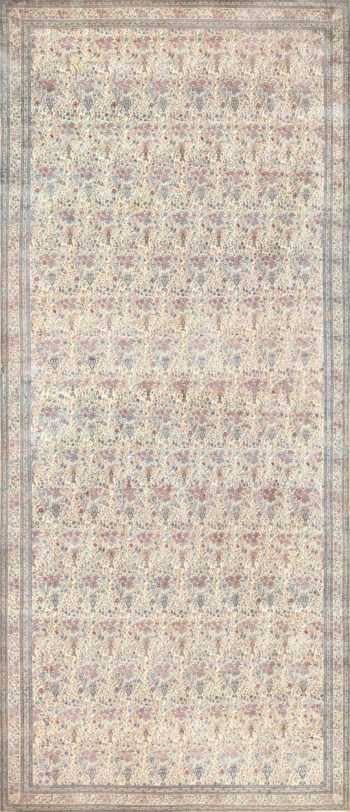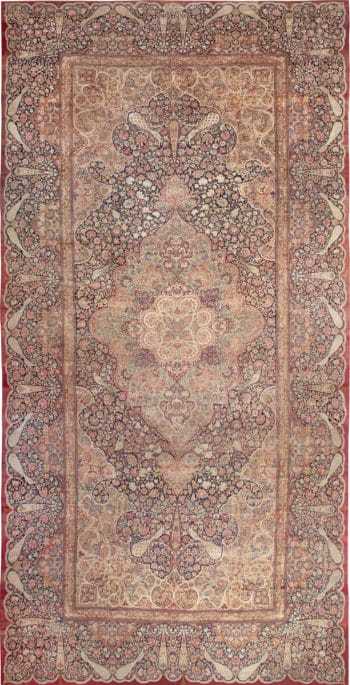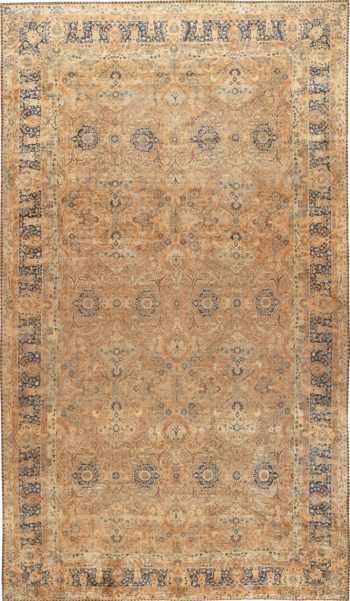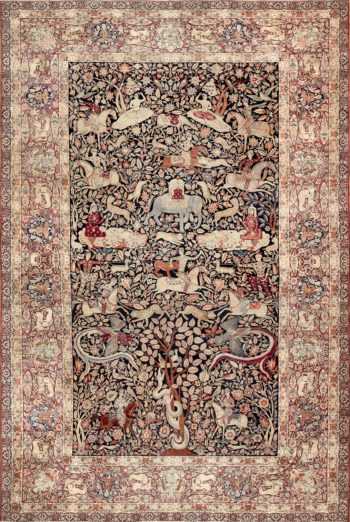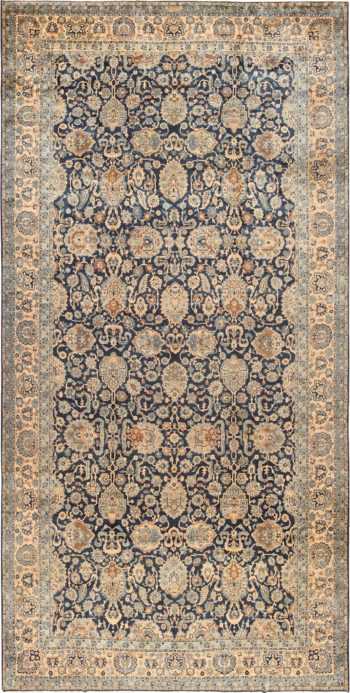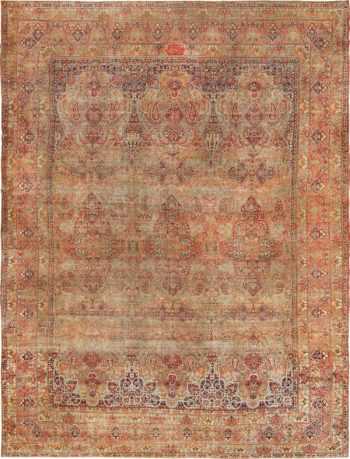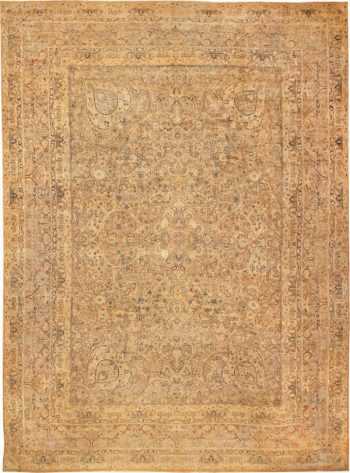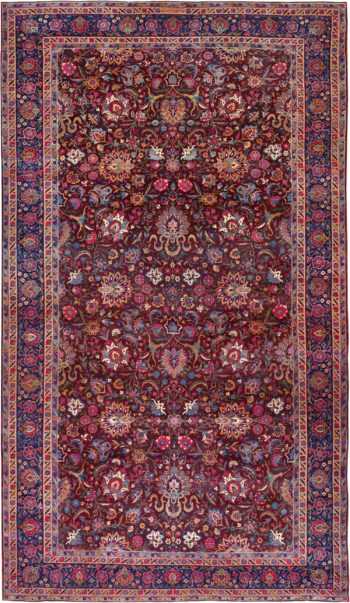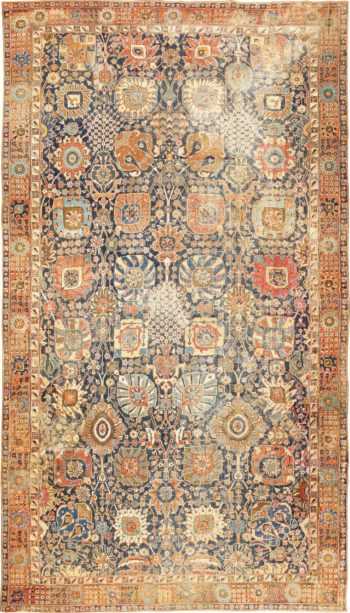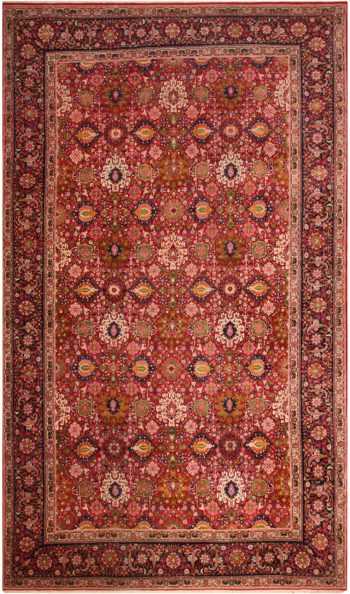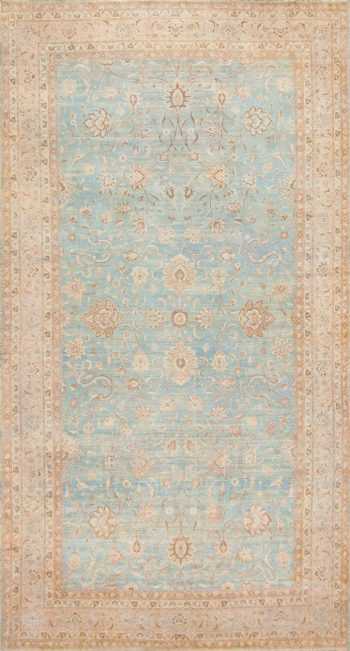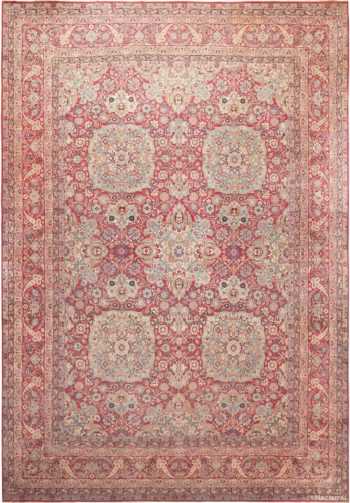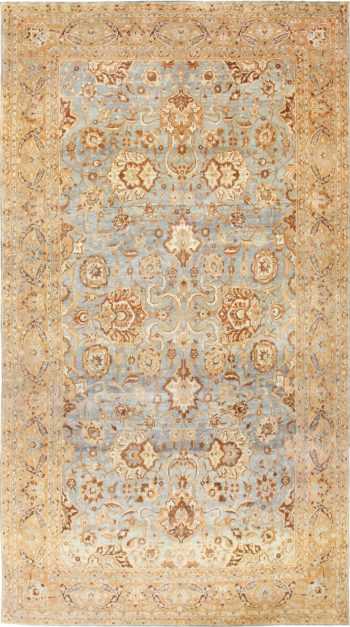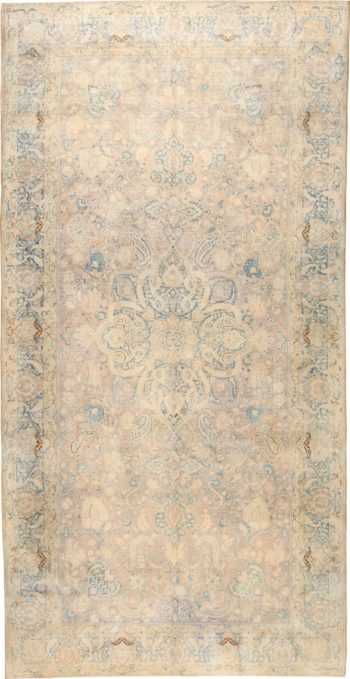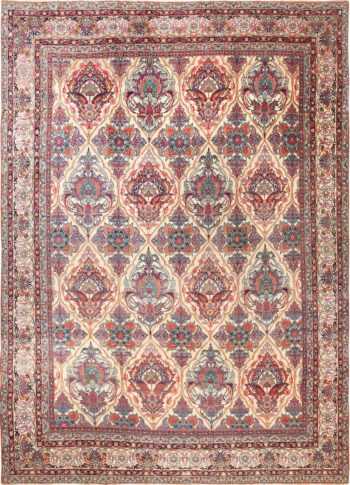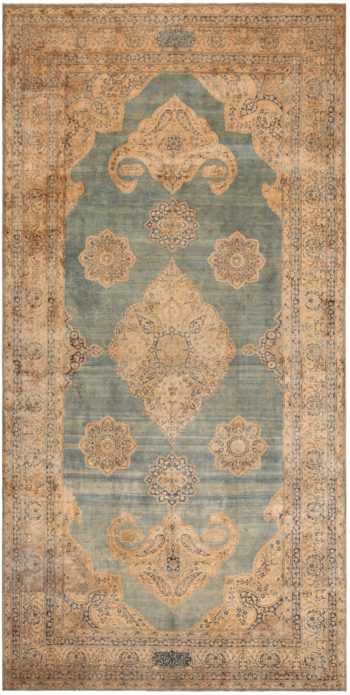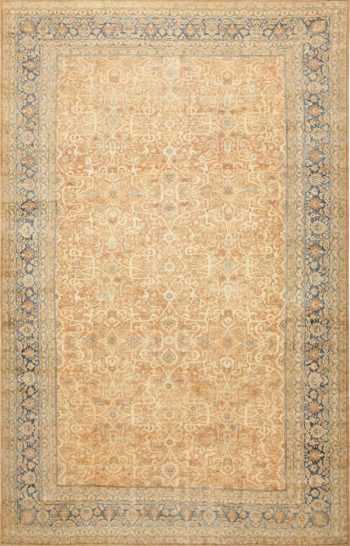Kerman Rugs & Carpets
Antique Kerman Rugs: Crafted Masterpieces For Your Home
View our current collection of antique Kerman rugs below
Fine Ivory Floral Palace Oversized Antique Allover Oriental Persian Kerman Rug 48370
$140,000.00Size: 19 ft 7 in x 41 ft (5.97 m x 12.5 m)Fine Oversized Floral Animal Design Antique Persian Kerman Rug 72499
$88,000.00Size: 14 ft 3 in x 29 ft 8 in (4.34 m x 9.04 m)Oversized Floral Antique Persian Kerman Rug 70936
$145,000.00Size: 13 ft 6 in x 24 ft 2 in (4.11 m x 7.37 m)Decorative Neutral Oversized Antique Persian Kerman Rug 49335
$96,000.00Size: 13 ft 7 in x 23 ft (4.14 m x 7.01 m)Oversized Antique Persian Hunting Scene Kerman Rug 48796
$375,000.00Size: 14 ft 8 in x 22 ft 8 in (4.47 m x 6.91 m)Finely Woven Large Oversized Antique Persian Kerman Rug 48945
$145,000.00Size: 16 ft x 22 ft 6 in (4.88 m x 6.86 m)Blue Background Large Scale Allover Design Oversized Antique Decorative Persian Kerman Rug 70932
$56,500.00Size: 11 ft 4 in x 22 ft 2 in (3.45 m x 6.76 m)Antique Oversize Persian Lavar Kerman Rug 49681
$56,000.00Size: 15 ft x 21 ft 8 in (4.57 m x 6.6 m)Large Oversized Antique Persian Kerman Rug 42880
$125,000.00Size: 15 ft 9 in x 21 ft 6 in (4.8 m x 6.55 m)Oversized Antique Aubergine Persian Kerman Area Rug 44830
$42,000.00Size: 11 ft 8 in x 21 ft 2 in (3.56 m x 6.45 m)Oversized Fine Weave Soft Ivory and Light Blue Color Antique Persian Kerman Area Rug 70935
$145,000.00Size: 17 ft 3 in x 21 ft (5.26 m x 6.4 m)Beautiful Fine Luxurious Oversized Antique Large Scale Allover Kerman Persian Rug 48690
$165,000.00Size: 14 ft 8 in x 21 ft (4.47 m x 6.4 m)Antique 17th Century Persian Vase Kerman Carpet 45770
Size: 11 ft 5 in x 20 ft 2 in (3.48 m x 6.15 m)Large Antique Happy Jewel Tone Persian Kerman Rug 71576
$58,000.00Size: 11 ft 10 in x 20 ft (3.61 m x 6.1 m)Decorative Allover Design Antique Shabby Chic Persian Kerman Rug 50077
$58,000.00Size: 13 ft 10 in x 20 ft (4.22 m x 6.1 m)Large Antique Sky Blue Persian Kerman Carpet 46979
$126,000.00Size: 10 ft 9 in x 20 ft (3.28 m x 6.1 m)Fine Decorative Soft Color Large Size Floral Design Vintage Persian Kerman Medallion Rug 71775
Size: 13 ft x 19 ft 9 in (3.96 m x 6.02 m)Extremely Fine and Intricate Floral Large Antique Persian Kerman Rug 70942
$125,000.00Size: 14 ft 2 in x 19 ft 8 in (4.32 m x 5.99 m)Fine Large Soft Light Blue Antique Decorative Persian Kerman Rug 49835
$88,000.00Size: 12 ft 10 in x 19 ft 7 in (3.91 m x 5.97 m)Antique Beautiful Fine Large Size Light Blue Persian Kerman Rug 48869
$96,000.00Size: 10 ft 6 in x 19 ft (3.2 m x 5.79 m)Large Antique Fine Persian Kerman Rug 50137
$42,000.00Size: 10 ft x 19 ft (3.05 m x 5.79 m)Large Finely Woven Formal Jewel Tone Antique Persian Kerman Rug 70219
$96,000.00Size: 13 ft 6 in x 18 ft 9 in (4.11 m x 5.71 m)Gallery Size Blue Background Antique Persian Kerman Rug 71336
$32,000.00Size: 9 ft x 18 ft (2.74 m x 5.49 m)Large Decorative Antique Persian Lavar Kerman Rug 47185
$64,000.00Size: 11 ft 6 in x 18 ft (3.51 m x 5.49 m)
Learn More About Antique Kerman Rugs
What are Kerman rugs?
Kerman rugs are a type of Persian rug that originates from the city of Kerman in southeastern Iran. Kerman is renowned for its long history of carpet weaving, dating back several centuries. The art of carpet making in Kerman has been influenced by various cultures, resulting in a unique and diverse range of designs.
Characterized by intricate patterns, vibrant colors, and high-quality craftsmanship, Kerman rugs are highly prized in the world of oriental carpets. These rugs often feature floral motifs, intricate medallions, and elaborate borders. The color palette of Kerman rugs can include rich reds, blues, greens, and ivory, contributing to their overall aesthetic appeal.
Kerman rugs are typically hand-knotted, with skilled artisans using a variety of materials such as wool or silk. The combination of fine materials and meticulous craftsmanship contributes to their durability and artistic value.
Over the years, Kerman has produced a wide range of carpet styles, including traditional, antique, and more contemporary designs. Kerman rugs are sought after by collectors and enthusiasts for their beauty, craftsmanship, and cultural significance.
Why do people shop for Kerman rugs specifically?
People often seek Persian Kerman rugs for several reasons, including:
- Artistic Beauty: Kerman rugs are known for their exquisite artistic designs, intricate patterns, and vibrant colors. The level of craftsmanship involved in creating these rugs is often considered to be of high quality, making them aesthetically appealing.
- Cultural Significance: The rugs woven in Persia, in general, hold cultural significance and are considered to be a form of art deeply rooted in the history and traditions of the region. Kerman, with its rich history of carpet weaving, contributes to this cultural legacy.
- History and Tradition: Kerman has a long and esteemed tradition of carpet making that dates back centuries. People who appreciate historical and traditional craftsmanship may be drawn to Kerman rugs for their authenticity and connection to the past.
- Investment: Iranian rugs, including those from Kerman, are often viewed as valuable investments. High-quality, handmade rugs can appreciate in value over time, making them attractive to collectors and investors.
- Craftsmanship and Materials: Kerman rugs are typically hand-knotted by skilled artisans, using high-quality materials such as wool or silk. The attention to detail and the use of fine materials contribute to the durability and longevity of these rugs.
- Versatility in Design: Kerman rugs come in a variety of designs, ranging from traditional to more contemporary styles. This versatility allows buyers to find a rug that suits their personal taste and complements their home decor.
- Status Symbol: The rugs woven in Persia, including Kerman rugs, have historically been associated with wealth and prestige. Owning a Persian rug can be seen as a symbol of luxury and sophistication.
- Collector’s Item: Some individuals are avid collectors of Persian weavings, including those specifically from Kerman. Collectors may seek out rare or antique pieces, appreciating the historical and cultural value of these carpets.
Overall, people shop for Persian Kerman rugs for their combination of artistic beauty, cultural significance, historical legacy, and potential investment value. The unique designs and meticulous craftsmanship make them desirable for those looking to enhance their living spaces with a touch of elegance and tradition.
More about the antique Persian Kerman rugs:
Since the seventeenth century, Kerman has been one of the major weaving centers where some of the finest high-quality carpets from Persia were woven. The so-called Vase Carpets of the Safavid period are among the greatest masterpieces of Persian weaving. When rug production moved into high gear in Persia, during the later nineteenth century, Kerman once again emerged as a producer of the finest carpets in the best Persian tradition.
Kerman carpets of this period, particularly the Lavar type, are known for the fineness of their weave and for their elegantly drawn designs of classical derivation, both in allover and central medallion formats. The palettes of Kerman rugs are extremely varied and it ranges from examples which emphasize ivory, blue, and magenta rug tones to those with a more golden, saffron cast.
Kerman is a city and as well as a province in south central Iran. With its 60,000 inhabitants and surrounding villages, it is one of the major rug producing areas of Iran. Unlike other parts of Persia, Kerman existed with relatively no interference from invasions, mostly due to its provincial isolation. As a result, the arts in Kerman flourished. Antique Kerman rugs are easily recognizable with curvilinear graceful floral designs in a brilliant assortment of colors.
The dyes of Kerman are the most varied and imaginative. The dying process is done while the wool is still in the flock, before spinning, allowing for more uniformity of color. The dyers of Kerman are renowned for their skill in producing light shades of color. Kerman is also noted for its distinctive late 16th century to mid-17th century carpets called ‘vase carpets’. This term refers to a design of all-over stylized flowers and oversized palmettes with vases placed at intervals throughout the field. Kermans are woven in all rug sizes and the foundation is often cotton. To the north of Kerman is the village of Ravar where Laver Kerman rugs are made. These rugs are rarer than Kermans and the name is used as a distinction of quality.
Among all the rugs woven in Persia, none may be argued to be more elegant and refined as those produced in the city of Kerman. Kerman rugs often feature traditional Persian reds and blues or variations thereof and are nearly always floral and curvilinear in design. The fineness and quality antique rugs of Kerman weaves in combination with their traditional Persian floral designs make them ideal for those wishing to add grace and grandeur to the formal spaces of their home.
Despite its geographical remove and dry climate, the city of Kerman and the surrounding region has long produced wool of exceptional quality, and it had already become an established center of rug production by the Safavid period. The famed Kerman ‘vase carpets’ rank among the greatest masterpieces of this era.
Kerman naturally assumed a prominent place in the rug revival of the later nineteenth century, when it achieved prominence for the unusually large range of dyes that it produced, endowing its rugs with remarkable effects of color. True to Safavid precedent, these Kerman rugs were produced in an extremely fine technique with a knot count ranging from the one hundreds to the low four hundreds.
After 1920, the designs became simpler, with a less varied, pastel palette, thicker pile and a lower knot count, mostly in response to American market demand. In the last forty years, however, there has been a return to the classic Kerman made around 1900 and earlier, once again utilizing a richer, more varied range of color, more traditional Safavid designs, and the finer weaving technique appropriate to the intricate detail of classic Kermans.
Interior Design With Antique Kerman Rugs From Persia
Decorating an interior with an antique Kerman rug from Persia presents a designer with a great host of options.
Antique Kerman rugs have been prized and widely sought after since as early as the seventeenth century, and Kerman rugs are widely considered to be among the finest, most masterfully-crafted of all antique rugs.
Kerman rugs of the Lavar variety are considered to be especially fine examples of antique Oriental rugs, and may feature either an allover pattern or a classical central medallion.
This fineness and variety gives the designer a great deal of flexibility: the impressive overall quality of the best Kerman carpet makes such pieces ideal for decorating formal interiors, and the range in patterns means that it is more likely that a designer will be able to find the right Kerman for that tricky space.

Antique Persian Kerman Rug In DC Home Office Interior
Kerman rugs typically feature traditional Persian reds and blues, as well as variations thereupon. And while Kerman rugs mayor may not have a central medallion design, floral elements are common across the entire range of Kermans.
In the photo above, a gorgeous, beautifully made Kerman rug serves to highlight the modern aesthetic that prevails throughout the room by underscoring with elegance and timeless beauty. This room exemplifies the tremendous flexibility that designers have with Kerman rugs: these pieces are so finely made that they look equally remarkable in modern interiors as well as more traditionally designed an decorated spaces.
The History of Persian Kerman Rugs
Since the early 17th century, Kerman carpets (Alt. Spelling: Kirman) have been exported to western markets where they have consistently ranked among the best of the best in the upper echelons of area rugs.
The history of carpet weaving and textile production in Kerman dates back before the city gained its modern name. The earliest carpet artifacts of Kerman date back to the 1500s, but depictions of opulent carpets decorating the courts of Persian emperors date back more than 2,500 years.
Located in the rugged, high-altitude plains of southeast Iran, Kerman is both a province and a provincial capital often associated with surrounding counties and cities, including the famed carpet-producing village of Lavar, which developed its own group of designs.
Kerman was established in the 3rd century as a military outpost and citadel for the Sassanid Empire.
Kerman has been known by different names over the course of the centuries, including Karmania, Kermania and Zhermanya – each of which stems from words related to bravery in combat.
As power fluxed between ethnic groups and religions, Kerman remained part of the greater Persian Empire, which was controlled by a number of independent groups before the year 725 when Islamic leaders became the predominant imperial force.
By the 8th century, Kerman had gained a reputation for producing fine Cashmere shawls and textiles from luxurious fiber obtained from the Kashmir goat, resulting in a distinct antique rug style.
As a defense outpost, Kerman was an unavoidable stop from travelers and merchants on the Silk Road. With access to international trade routes, carpets and textiles from Kerman were distributed east to India and China and west to Anatolia and European countries.
In 1271, the legendary traveler and merchant Marco Polo visited the city of Kerman . Accounts of his visit include details of plentiful turquoise mines and advanced steel production. However, his most prolific paragraphs on industry in Kerman mention the exquisite textiles, needlework and decorative embroidery produced by the women and girls in Kerman which he describes as marvels to see.
In addition to the silk embroidery and colorful threads, Marco Polo mentions the animals, birds, trees and flowers used to decorate the local textiles.
When Marco Polo arrived in Kerman , the city was formally ruled by Seljuk Turks from the Kazakh Steppe. However, the fragmented government of the Seljuk Sultanates left the province of Kerman largely under its own control.
From the 13th century through the 16th century, Kerman and the greater Persian Empire experienced constant power struggles between the Mongols, Timur the Great and finally the Safavids.
During the 17th century, Kerman for the Portuguese crown, ranked Kerman carpets as the second best in Persia behind the neighboring province of Yazd and ahead of Khorasan to the north.
In the second half of the 17th century, Jean-Baptiste Chardin also known as Sir John Chardin commented on Kerman carpet production while compiling his ten-book series, which was one of the earliest and most comprehensive works on Persia and the Near East completed by a Western scholar.
During his travels through Kerman, Chardin noted that the province produced some of the finest carpets in Persia, which were often marketed as Turkish carpets due to the import route to Europe.
In Kerman, Muslim carpet weavers worked in studios small and large as well as private homes. Carpet weavers in Kerman produced a number of pictorial pieces as well as exclusive gift for foreign dignitaries. Due to the varied production settings, not many carpets from Kerman are signed by master weavers.
However, there were several prestigious workshops and weavers operating in Kerman between 1866 and 1915, which have made it possible to attribute these pieces and regional designs with astounding accuracy. As a city that flourished under Safavid rule, carpets from Kerman represent a broad range of patterns that encompasses the world of traditional Persian designs.
Click Here to Learn Everything You Want to Know About Area Rugs

